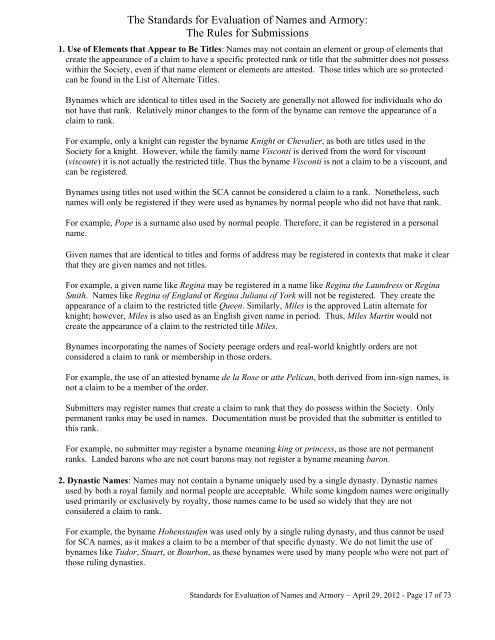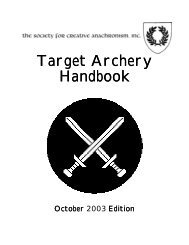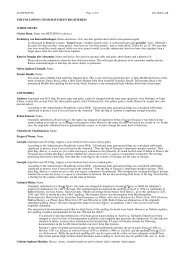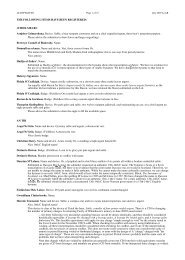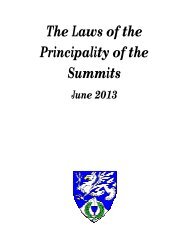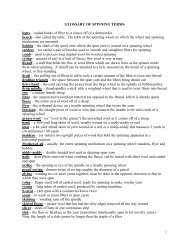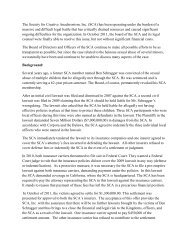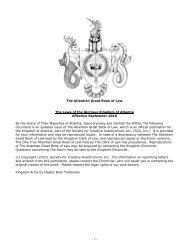The Standards for Evaluation of Names and Armory - SCA Heraldry
The Standards for Evaluation of Names and Armory - SCA Heraldry
The Standards for Evaluation of Names and Armory - SCA Heraldry
You also want an ePaper? Increase the reach of your titles
YUMPU automatically turns print PDFs into web optimized ePapers that Google loves.
<strong>The</strong> <strong>St<strong>and</strong>ards</strong> <strong>for</strong> <strong>Evaluation</strong> <strong>of</strong> <strong>Names</strong> <strong>and</strong> <strong>Armory</strong>:<strong>The</strong> Rules <strong>for</strong> Submissions1. Use <strong>of</strong> Elements that Appear to Be Titles: <strong>Names</strong> may not contain an element or group <strong>of</strong> elements thatcreate the appearance <strong>of</strong> a claim to have a specific protected rank or title that the submitter does not possesswithin the Society, even if that name element or elements are attested. Those titles which are so protectedcan be found in the List <strong>of</strong> Alternate Titles.Bynames which are identical to titles used in the Society are generally not allowed <strong>for</strong> individuals who donot have that rank. Relatively minor changes to the <strong>for</strong>m <strong>of</strong> the byname can remove the appearance <strong>of</strong> aclaim to rank.For example, only a knight can register the byname Knight or Chevalier, as both are titles used in theSociety <strong>for</strong> a knight. However, while the family name Visconti is derived from the word <strong>for</strong> viscount(visconte) it is not actually the restricted title. Thus the byname Visconti is not a claim to be a viscount, <strong>and</strong>can be registered.Bynames using titles not used within the <strong>SCA</strong> cannot be considered a claim to a rank. Nonetheless, suchnames will only be registered if they were used as bynames by normal people who did not have that rank.For example, Pope is a surname also used by normal people. <strong>The</strong>re<strong>for</strong>e, it can be registered in a personalname.Given names that are identical to titles <strong>and</strong> <strong>for</strong>ms <strong>of</strong> address may be registered in contexts that make it clearthat they are given names <strong>and</strong> not titles.For example, a given name like Regina may be registered in a name like Regina the Laundress or ReginaSmith. <strong>Names</strong> like Regina <strong>of</strong> Engl<strong>and</strong> or Regina Juliana <strong>of</strong> York will not be registered. <strong>The</strong>y create theappearance <strong>of</strong> a claim to the restricted title Queen. Similarly, Miles is the approved Latin alternate <strong>for</strong>knight; however, Miles is also used as an English given name in period. Thus, Miles Martin would notcreate the appearance <strong>of</strong> a claim to the restricted title Miles.Bynames incorporating the names <strong>of</strong> Society peerage orders <strong>and</strong> real-world knightly orders are notconsidered a claim to rank or membership in those orders.For example, the use <strong>of</strong> an attested byname de la Rose or atte Pelican, both derived from inn-sign names, isnot a claim to be a member <strong>of</strong> the order.Submitters may register names that create a claim to rank that they do possess within the Society. Onlypermanent ranks may be used in names. Documentation must be provided that the submitter is entitled tothis rank.For example, no submitter may register a byname meaning king or princess, as those are not permanentranks. L<strong>and</strong>ed barons who are not court barons may not register a byname meaning baron.2. Dynastic <strong>Names</strong>: <strong>Names</strong> may not contain a byname uniquely used by a single dynasty. Dynastic namesused by both a royal family <strong>and</strong> normal people are acceptable. While some kingdom names were originallyused primarily or exclusively by royalty, those names came to be used so widely that they are notconsidered a claim to rank.For example, the byname Hohenstaufen was used only by a single ruling dynasty, <strong>and</strong> thus cannot be used<strong>for</strong> <strong>SCA</strong> names, as it makes a claim to be a member <strong>of</strong> that specific dynasty. We do not limit the use <strong>of</strong>bynames like Tudor, Stuart, or Bourbon, as these bynames were used by many people who were not part <strong>of</strong>those ruling dynasties.<strong>St<strong>and</strong>ards</strong> <strong>for</strong> <strong>Evaluation</strong> <strong>of</strong> <strong>Names</strong> <strong>and</strong> <strong>Armory</strong> – April 29, 2012 - Page 17 <strong>of</strong> 73


